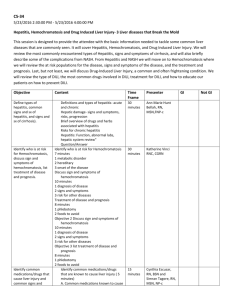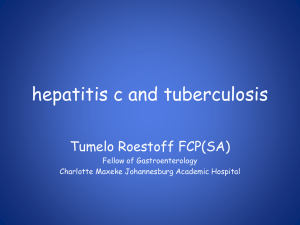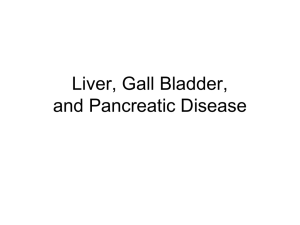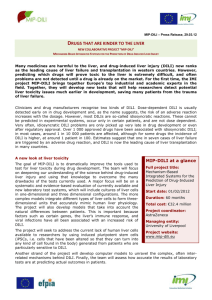DILI_implementation_031813_Mayo_V2
advertisement
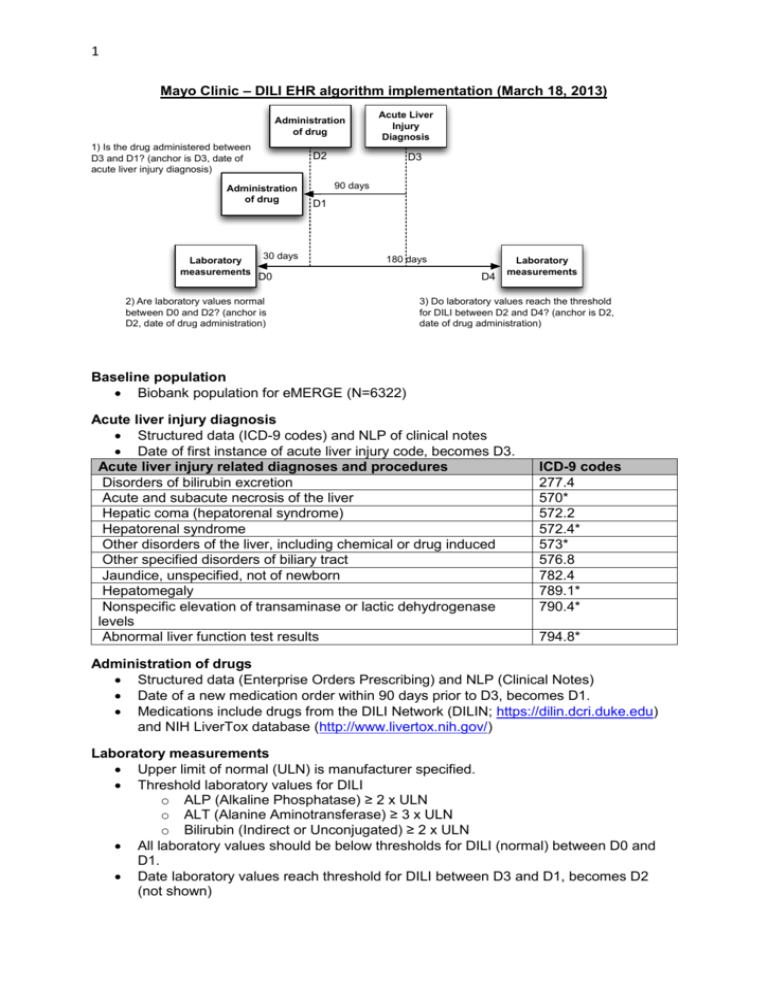
1 Mayo Clinic – DILI EHR algorithm implementation (March 18, 2013) Administration of drug 1) Is the drug administered between D3 and D1? (anchor is D3, date of acute liver injury diagnosis) D2 Administration of drug Laboratory measurements Acute Liver Injury Diagnosis 30 days D3 90 days D1 180 days D0 2) Are laboratory values normal between D0 and D2? (anchor is D2, date of drug administration) D4 Laboratory measurements 3) Do laboratory values reach the threshold for DILI between D2 and D4? (anchor is D2, date of drug administration) Baseline population Biobank population for eMERGE (N=6322) Acute liver injury diagnosis Structured data (ICD-9 codes) and NLP of clinical notes Date of first instance of acute liver injury code, becomes D3. Acute liver injury related diagnoses and procedures Disorders of bilirubin excretion Acute and subacute necrosis of the liver Hepatic coma (hepatorenal syndrome) Hepatorenal syndrome Other disorders of the liver, including chemical or drug induced Other specified disorders of biliary tract Jaundice, unspecified, not of newborn Hepatomegaly Nonspecific elevation of transaminase or lactic dehydrogenase levels Abnormal liver function test results ICD-9 codes 277.4 570* 572.2 572.4* 573* 576.8 782.4 789.1* 790.4* 794.8* Administration of drugs Structured data (Enterprise Orders Prescribing) and NLP (Clinical Notes) Date of a new medication order within 90 days prior to D3, becomes D1. Medications include drugs from the DILI Network (DILIN; https://dilin.dcri.duke.edu) and NIH LiverTox database (http://www.livertox.nih.gov/) Laboratory measurements Upper limit of normal (ULN) is manufacturer specified. Threshold laboratory values for DILI o ALP (Alkaline Phosphatase) ≥ 2 x ULN o ALT (Alanine Aminotransferase) ≥ 3 x ULN o Bilirubin (Indirect or Unconjugated) ≥ 2 x ULN All laboratory values should be below thresholds for DILI (normal) between D0 and D1. Date laboratory values reach threshold for DILI between D3 and D1, becomes D2 (not shown) 2 Excluded diagnoses Structured data only (ICD-9 codes) Chronic liver disease diagnosis description Alcoholic fatty liver Alcoholic cirrhosis of liver Alcoholic liver damage Chronic hepatitis Chronic persistent hepatitis Other chronic hepatitis Cirrhosis of liver without mention of alcohol Biliary cirrhosis Other chronic nonalcoholic liver disease Autoimmune hepatitis Unspecified Chronic Liver Disease without Mention of Alcohol ICD-9 code 571.0 571.2 571.3 571.40 571.41 571.49 571.5 571.6 571.8 571.42 571.9 Validation steps Manual chart review of 50 algorithm-selected DILI cases and controls 1 highly experienced clinical reviewer (nurse coordinator for the Mayo Clinic DILIN site) Expert decision, determination by DILI expert (PI for Mayo Clinic DILIN site) for questionable results NLP implementation Case A: There is a mention of a Signs/Symptoms or Disorder Impression Report Plan (IRP)/History of Present Illness (HPI)/Chief Complaint sections (to cover examples like autoimmune hepatitis) and relevant medication in IRP/HPI/Chief Complaint sections, where SS/Disorder and Drug must be in the same section. Ex:auto-immune hep. Due to drug x Analysis (after initial run with this algorithm): If too many FPs decrease window to +/- 2 sentences surrounding the drug mentions Case B: There is a relevant SS in IRP/HPI/Chief Complaint sections or there is a Disorder (to cover examples like autoimmune hepatitis) in IRP/HPI/Chief Complaint sections and a relevant medication in Current medications, Dismissal medications or Admission medications sections. Ex: Sec=HPI; she complains of vomiting Sec=Current Medications; aspirin Case C: There is an explicit mention of "drug-induced **" terms, their variants or synonyms anywhere in the clinical note. Ex: drug-induced liver injury, etc But NOT cases like: auto-immune hep. NOTE: All Named Entities must be non-negated. 3 Drug Window is defined as follows (for relation assertion) anchor is the drug mention window for SS and disorders is +/- 2 sentences surrounding the drug mention Examples of query diagnosis (NLP terms): drug|drug induce cholestasis drug|drug induce hepatotocity drug|drug induce liver failure cholestasis|cholestasis cholestatic|cholestatic hepatitis hepatic|hepatic adverse drug reaction herbal|herbal hepatotoxicity Autoimmune hepatitis reactive hepatitis medication induced dysfunction acute hepatitis hepatitis eosinophilia Key signs and symptoms (NLP terms) fever|fever from the drug rash|rash from the drug itching|itching nausea|nausea pain|pain in the upper right part of the abdomen dark|dark urine pale|pale stools vomiting|vomiting yellow|yellow skin or eyes jaundice|jaundice fatigue|fatigue pruritis lethargy ascites Gray stools abnormal/ elevated LFT hepatitis or acute hepatitis encephalopathy abnormal/elevated liver enzymes abnormal/elevated transaminases 2) Evaluation of algorithm-selected cases Total algorithm selected DILI cases True positive cases (TPs) False positive cases (FPs) Positive predictive value: TP/(TP+FP) 3) Evaluation of “controls” Counts 25 4 21 16% 4 Total “controls” reviewed True negative cases (TNs) False negative cases (FNs) Negative predictive value: TN/(TN+FN) Counts 25 25 0 100%
